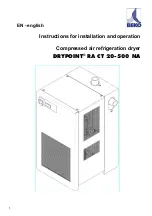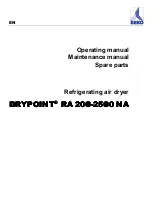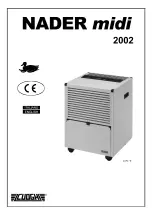
Page 9
HCSTEAM−16/−35 SERIES
S
Avoid the formation of pockets or traps where conden-
sate may form.
S
Avoid choking the hose due to tight bends or twisting.
S
Fasten the end of the hose to the steam hose adapter
on the humidifier and the steam nozzle using metal
hose clamps, so that these do not detach due to the
high temperature.
NOTES −
Slope piping up in direction of steam flow at 20º or greater (2−1/2" per foot [63 mm per 305 mm])
Slope piping down in direction of steam flow at 5º or greater (3/4" per foot [19 mm per 305 mm])
Max. length of rubber steam hose is 10’ (3 m)
TYPICAL INSTALLATION
WHEN UNIT IS ABOVE
THE STEAM NOZZLE
5 ft (1.5 M) MAX.
5 ft (1.5 M) MAX.
IF NO SLOPE
3" (.9M) MAX.
>20º
>5º
10 ft (3M) MAX.
5ft (1.5 M) MAX.
>20º
>5º
GENTLE
BEND
OBSTRUCTION
SUPPORTED STEAM HOSE
AND/OR COPPER PIPE
DRAINS
P−trap
NOTE − Height of traps must be greater than the
duct static pressure
DRAINS
>20º
>20º
Figure 9. Installing steam hoses
NOTE − Maximum length of rubber steam hose is 10 ft. (3 m). Insulated copper tubing may be up to 20 ft. (6 m) in length. In all
cases, minimize sharp bends and elbows. Use 2 − 45
elbows instead of 90
elbows. Hose inner diameter = 7/8" (22 mm);
Hose outer diameter = 1−1/4" (30 mm).
NO DISTRIBUTION
PIPE DRAIN
UN-
DRAINED
ELBOW
NO
SLOPE
UN-
DRAINED
ELBOW
SAG
NO TRAP
NO SLOPE
KINKED
Figure 10. Unacceptable examples of installing steam hoses










































